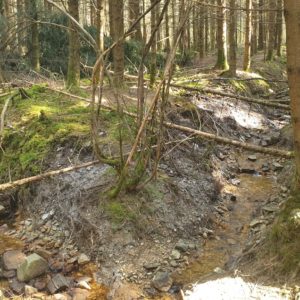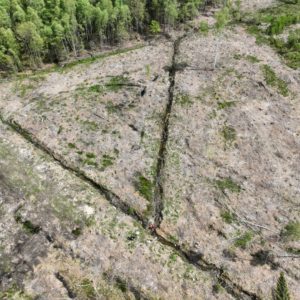
Restoring the natural sponge functioning of the River Bêche, Belgium
-
Rivers and Lakes
Restoration is underway to improve the sponge function of a 2 km2 landscape, transforming this upstream catchment into a biodiverse carbon sink that will help reduce future flood and drought risks in the region while improving water quality. The pilot site is an example of the muti-benefits offered by natural sponges.
As part of the EU Horizon Project Rewet, we are working with partner Bureau Stroming and the landowner Natagora, on restoration measures that began in late 2023 and will be completed in spring of 2024, with the objective of blocking drainage channels and elevating the water table so that a much larger fraction of the precipitation starts infiltrating the soil again. The result of the measures will be that water is retained longer and released slowly – like a natural sponge. Natagora previously removed the plantation spruce forest as part of the LIFE Nardus project to recreate habitat of high nature value.
The Natural Reserve Gérard & Francis Paquay (Quatre-Vents) is located within the Amblève river catchment in Belgium, near the village of Vielsalm in the Haute Ardennes region that stretches towards the borders of Germany and Luxembourg. This hilly area was once characterised by large areas of moors, one of Europe’s most threatened habitat types, which almost completely disappeared following the widespread drainage of soils for the planting of spruce tree plantations.

In 2021, the Amblève River severely flooded due to intense summer rains. The post-flood analysis found that drainage in upper catchment areas such as the Bêche channelled waters quickly downstream and amplified the flood peaks, eventually joining the floodwaters of the Meuse which is the largest river in the region, contributing to widespread devastation and the loss of life as it flowed from Belgium into the Netherlands.

This area is highly suitable for sponge restoration as it is an upper catchment in a middle mountain region that annually receives a lot of precipitation, with an elevation between 470 and 530 m above sea level and a slope of less than 10 per cent.
The result of restoring the sponge capacity should be a much slower, subsurface flow and a smaller proportion of precipitation traveling as a fast overland flow. In the event that precipitation intensity exceeds the infiltration capacity of the soil, overland flow still remains the dominant discharge process. It will however be slowed down by natural vegetation in comparison with the fast-flowing drainage channels.

We are currently monitoring progress while looking forward to see how the biodiversity, water flows and greenhouse gas emissions change in 2024 as a result of these simple measures. Beyond the pilot, the uppermost river catchments of the region are covered in spruce plantations on drained lands, and we hope to inspire the deployment and upscaling of this nature-based sponge solution in Wallonia in order to make people safer and benefit nature.
For more information:
